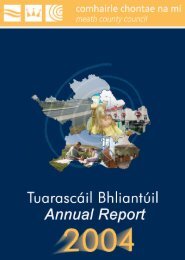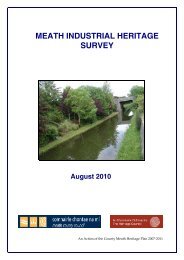Navan Points of Pride Brochure - Meath County Council
Navan Points of Pride Brochure - Meath County Council
Navan Points of Pride Brochure - Meath County Council
Create successful ePaper yourself
Turn your PDF publications into a flip-book with our unique Google optimized e-Paper software.
Follow the winding path through the green<br />
area, passing the library on your left. This<br />
path will bring you onto Circular Road. Turn<br />
right and walk to the first junction, which<br />
is the junction with Academy Street.<br />
St. Finian’s Seminary was the first Catholic seminary to be founded in the<br />
northern half <strong>of</strong> Ireland after the Penal days. The first president <strong>of</strong> the school<br />
was Rev. Eugene O’Reilly who directed the school until 1827 when he became<br />
Parish Priest <strong>of</strong> <strong>Navan</strong>. In 1835 it is described as a boarding and day school. In<br />
1908 the land was sold, the seminary was moved to Mullingar in county<br />
Westmeath, and the <strong>County</strong> Hall was built on seminary land. Now all that<br />
survives <strong>of</strong> St. Finian’s Seminary is the study hall, the ro<strong>of</strong> and walls <strong>of</strong> which<br />
you can see if you look back and up, at the junction between Circular Road and<br />
Academy Street. Built in the 1840s in an unusual oval shape, generations <strong>of</strong><br />
<strong>Navan</strong> schoolboys have known it as ‘Power’s Duck Egg’, after Headmaster<br />
Power, who built it. Charles Stewart Parnell’s political career began here, with<br />
his selection as the Home Rule candidate for <strong>Meath</strong> at the great <strong>County</strong> Rally<br />
held on April 12th, 1875. To celebrate his election, the townspeople decorated<br />
their house fronts with sprigs <strong>of</strong> laurel and ivy.<br />
2<br />
Academy St. / John Boyle O’Reilly<br />
In the fanlight <strong>of</strong> one <strong>of</strong> the early 19th century houses on Academy Street, you<br />
can make out the word Moondyne. John Boyle O’Reilly, patriot, rebel, newspaper<br />
editor, poet and laureate <strong>of</strong> Boston, lived here for a few years and was inspired<br />
to use it for the title <strong>of</strong> his novel ‘Moondyne Joe: A Story From The<br />
Underworld’, which was published in New York in 1879.<br />
The Railway Viaduct, which crosses the river Boyne here is 122m long and<br />
was built in 1850 for the Dublin & Belfast Railway Company by Moore Brothers<br />
to the design <strong>of</strong> Sir John MacNeill. It carries the 27km branch line from<br />
Drogheda to <strong>Navan</strong> and consists <strong>of</strong> seven semicircular masonry arches, which<br />
cross the river and two roadways.<br />
The cottages further down on the left side <strong>of</strong> the road were originally thatched<br />
with wheat and oaten straw and are traditionally known as Butterstream (in<br />
Irish ‘Bóthar an tSirriam’, or ‘The Sheriff’s Road’).<br />
Now cross the junction at Academy Street and<br />
Circular Road at the pedestrian crossing. Walk up<br />
the street in front <strong>of</strong> you called Bridge Street.




